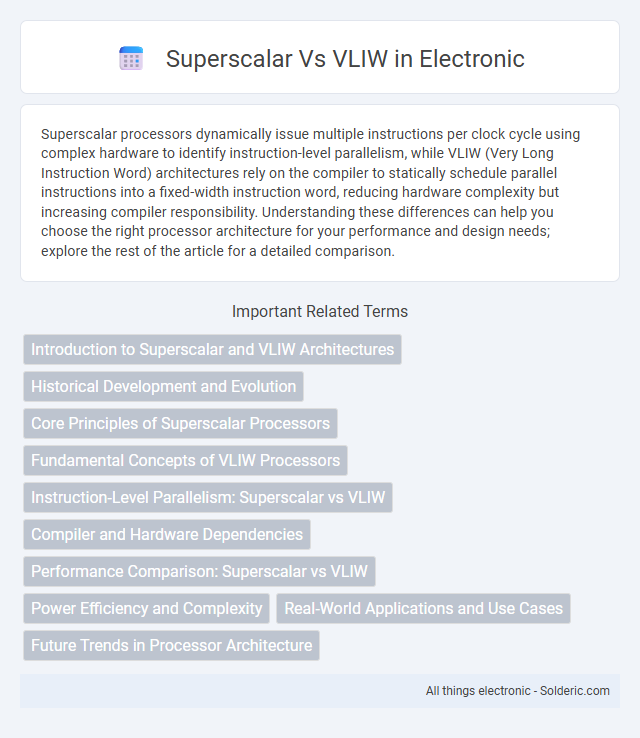Superscalar processors dynamically issue multiple instructions per clock cycle using complex hardware to identify instruction-level parallelism, while VLIW (Very Long Instruction Word) architectures rely on the compiler to statically schedule parallel instructions into a fixed-width instruction word, reducing hardware complexity but increasing compiler responsibility. Understanding these differences can help you choose the right processor architecture for your performance and design needs; explore the rest of the article for a detailed comparison.
Comparison Table
| Feature | Superscalar | VLIW (Very Long Instruction Word) |
|---|---|---|
| Execution Model | Dynamic multiple instruction issue | Static multiple instruction issue |
| Instruction Scheduling | Hardware-based | Compiler-based |
| Complexity | High hardware complexity | Simple hardware, complex compiler |
| Parallelism | Dynamic exploitation of instruction-level parallelism (ILP) | Explicit ILP encoded by the compiler |
| Instruction Width | Variable, single instructions issued in parallel | Fixed, long instruction bundles |
| Dependence Handling | Handled by hardware at runtime | Handled by compiler at compile time |
| Performance | Adaptive to runtime behavior, improved throughput | Performance depends on compiler effectiveness |
| Code Size | Smaller binary size | Larger code size due to instruction padding |
| Examples | Intel Pentium Pro, AMD Athlon | Intel Itanium, STMicroelectronics ST200 |
Introduction to Superscalar and VLIW Architectures
Superscalar architecture dynamically issues multiple instructions per clock cycle using hardware-based instruction scheduling and dependency checking to optimize parallelism. VLIW (Very Long Instruction Word) architecture relies on the compiler to statically schedule instructions into long instruction words, enabling multiple operations to execute simultaneously without complex hardware. Both architectures aim to increase instruction-level parallelism but differ in complexity, hardware design, and compiler responsibilities.
Historical Development and Evolution
Superscalar processors evolved in the 1980s as an advancement in CPU architecture to dynamically issue multiple instructions per clock cycle using complex hardware scheduling and dependency checking. VLIW (Very Long Instruction Word) architecture, pioneered around the same time, relies on the compiler to statically bundle multiple operations into long instruction words, simplifying hardware but requiring sophisticated compiler technology. Understanding these historical developments helps you appreciate how modern CPUs balance hardware complexity and compiler design to optimize instruction-level parallelism.
Core Principles of Superscalar Processors
Superscalar processors achieve instruction-level parallelism by dynamically issuing multiple instructions per clock cycle using hardware-based scheduling and out-of-order execution. They rely on complex control logic, including dynamic branch prediction, register renaming, and hazard detection, to optimize instruction throughput without explicit compiler intervention. This architecture contrasts with static scheduling in VLIW processors, where the compiler handles instruction parallelism prior to execution.
Fundamental Concepts of VLIW Processors
VLIW (Very Long Instruction Word) processors execute multiple operations in a single instruction cycle by packing independent instructions into a long instruction word at compile time, relying on the compiler to identify parallelism. Unlike superscalar architectures that use dynamic hardware scheduling for parallel instruction issue, VLIW simplifies hardware design by shifting the complexity of instruction-level parallelism extraction to the compiler. This fundamental concept enables VLIW processors to achieve high performance with lower control complexity, benefiting from predictable instruction execution patterns.
Instruction-Level Parallelism: Superscalar vs VLIW
Superscalar architectures dynamically extract instruction-level parallelism (ILP) by dispatching multiple instructions per cycle using hardware-based scheduling and dependency checking. VLIW (Very Long Instruction Word) relies on the compiler to statically schedule instructions into wide instructions that execute in parallel, removing the need for complex hardware scheduling. Superscalar designs adapt to runtime conditions, whereas VLIW depends on compile-time ILP analysis for optimal performance.
Compiler and Hardware Dependencies
Superscalar processors rely heavily on dynamic hardware mechanisms for instruction scheduling and parallelism, reducing the compiler's role in optimization. VLIW architectures shift complexity to the compiler, which statically schedules instructions and bundles them for parallel execution, requiring sophisticated compiler support. This results in Superscalar designs demanding more complex hardware logic, while VLIW depends more on advanced compiler technology for efficient performance.
Performance Comparison: Superscalar vs VLIW
Superscalar processors dynamically issue multiple instructions per clock cycle by analyzing instruction dependencies at runtime, offering higher flexibility and better handling of unpredictable workloads. VLIW architectures rely on compilers to statically schedule instructions for parallel execution, which can deliver peak performance for well-optimized code but may suffer from inefficiency with less predictable instruction streams. Your choice between Superscalar and VLIW will impact performance based on the workload's predictability and the efficiency of the compiler's scheduling capabilities.
Power Efficiency and Complexity
Superscalar processors use dynamic instruction scheduling and complex hardware for out-of-order execution, resulting in higher power consumption and design complexity. VLIW architectures rely on compiler-driven static scheduling, which reduces hardware complexity and improves power efficiency by simplifying instruction dispatch. Your choice between the two impacts power efficiency, with VLIW offering a more energy-efficient solution for certain embedded or low-power applications.
Real-World Applications and Use Cases
Superscalar architectures are widely used in general-purpose processors like Intel's Core series and AMD Ryzen, enabling high single-thread performance through dynamic instruction scheduling and out-of-order execution. VLIW (Very Long Instruction Word) architectures excel in embedded systems and DSP (Digital Signal Processing) applications, such as Texas Instruments' C6000 series, where compiler-driven static scheduling optimizes parallel execution with predictable performance. You benefit from superscalar CPUs in everyday computing tasks, while VLIW processors are preferred in specialized environments demanding efficient, high-throughput instruction pipelines.
Future Trends in Processor Architecture
Future trends in processor architecture emphasize enhanced parallelism through both Superscalar and VLIW designs, with Superscalar processors improving dynamic instruction scheduling and branch prediction for better real-time adaptability. VLIW architectures continue evolving by relying on compile-time instruction scheduling to achieve high instruction-level parallelism with simpler hardware, reducing power consumption and complexity. Your choice between these architectures may hinge on specific application needs, balancing dynamic flexibility with static efficiency in evolving multicore and heterogeneous computing environments.
Superscalar vs VLIW Infographic

 solderic.com
solderic.com